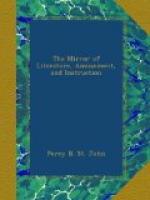chancel, and decorated with an amazing variety of
mouldings. Those below form the grand characteristic
of this venerable pile, being likewise circular;
but so intersecting one another as to form perfect
and beautiful pointed arches.” This
then is the hypothesis of Dr. Milner towards the settlement
of the controverted origin of the pointed or
English style of architecture. It is,
probably, the most reasonable of all solutions.
Sir Christopher Wren’s account of a Saracenic
origin was vague and unsupported; and Warburton’s
deduction from groves and interlacing boughs, though
ingeniously illustrated by the late Sir James Hall,
has more prettiness than probability. Dr. Milner’s
“intersecting hypothesis,” as it is technically
termed, is brief and simple: “De Blois,”
he says, “having resolved to ornament the whole
sanctuary of his church with intersecting semicircles,
conceived the idea of opening them, by way of windows,
which at once produced a series of highly-pointed
arches.” Hence arose the seeming paradox,
that “the intersection of two circular arches
in the church of St. Cross, produced Salisbury steeple.”
Conclusive as this hypothesis may appear, it has been
much controverted, and among its opponents have been
men of great practical knowledge in architecture.
Messrs. Brayley and Britton observe “though
the specimens referred to by Dr. Milner may not entirely
warrant the above supposition, yet they clearly mark
the gradation by which the Saxon and Norman styles
of architecture were abandoned, for the more enriched
and beautiful order that has conferred so much celebrity
on the ecclesiastical architects of this country."[9]
The clever writer in The Crypt remarks “the
history of the science appears so easy and natural
according to Dr. Milner’s hypothesis, and so
many difficulties must be softened down, so many discordances
reconciled, according to any other, as to go a very
great way towards establishing the credibility of
his idea. Here then is a complete history of
an invention, for which every quarter of the globe
has been ransacked. And, be it remembered, that
the pointed arch did not first display itself in those
magnificent proportions, which would have accompanied
it from the beginning, if brought over from foreign
climes in its full perfection; but exactly in that
want of proportion, which was the natural result of
the intersection."[10]
[9] Beauties of England, vol. vi. p 110.
[10] The specimens at St. Cross
were considered by Dr. Milner
to be the earliest instances of the experiment,
but the
Abbey of Clugny, and several other edifices
have disputed
its claim to priority.—The
Crypt, No. 8.
To return to the choir. On each side of the altar is curious and elegant Gothic spire-work; and traces may be seen of ancient stone work, all that now remains of the high altar. The wooden altar-screen is described as “execrable enough”; but sixteen stalls in the choir, which are referred to the time of Henry VII., are ingeniously ornamented with “carved figures of illustrious scripture personages."[11]




